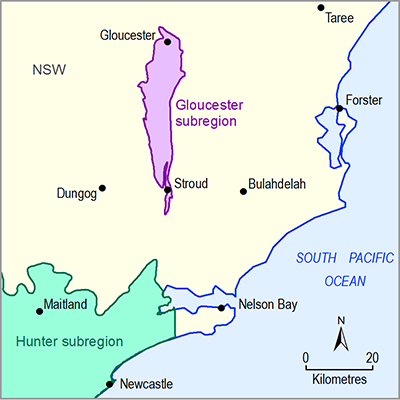2.6.2.4.3.1 Analytic element model
Surface water features were not included in the GW AEM; these are accounted for in the MODFLOW models that represent the alluvial system. A more detailed discussion on this rationale and the effect on predictions is provided in the qualitative uncertainty analysis in Section 2.6.2.8.
2.6.2.4.3.2 Alluvial MODFLOW models
As discussed in Section 2.1.5.1.2 in companion product 2.1-2.2 for the Gloucester subregion (Frery et al., 2018) and in Section 7.4 in Parsons Brinckerhoff (2015), the Avon and Karuah river systems are considered to be gaining systems (i.e. the alluvial groundwater discharges water into the river system). Only during short periods of very high stream levels does the river provide water to the alluvial aquifer. This is illustrated in Figure 13.
Bore TMB01 is 2 m from the stream gauge TWS01, TMB02 is 328 m away and TMB03 is 662 m away; CTF = cease to flow; GL = ground level.
Data: AGL (Dataset 1)
Two of the commonly used implementations of the Cauchy boundary condition, or head-dependent flux boundary, to represent surface water – groundwater interaction available in MODFLOW are the DRAIN package and the RIVER package (Brunner et al., 2010).
In the DRAIN package an invert level or drain elevation is specified together with a drainbed conductance. Drainage, water leaving the groundwater system through that boundary, only occurs if the simulated groundwater level in the grid cell specified as a DRAIN cell exceeds the invert level. The drainage flux is calculated based on the head gradient between the invert level and the groundwater level and the drainbed conductance. This boundary condition therefore only allows water to leave the system, no water enters the groundwater system if the groundwater level is below the invert level.
In the RIVER package, on the contrary, this two-way interaction is possible. In a RIVER grid cell, the river stage and the river bed elevation is specified as well as the riverbed conductance. The flux through the boundary condition is calculated based on the head difference between the simulated groundwater level and the river stage. If the groundwater level is above the river stage, this boundary acts very similar to the DRAIN package, and flow leaves the groundwater system. When groundwater levels are simulated that are lower than the river stage, water will flow from the river into the groundwater system.
In the Avon and Karuah MODFLOW models, rivers are represented through the DRAIN package, with the drainbed elevation set to 4 m below the land surface.
The obvious drawback of choosing the DRAIN boundary condition is that losing river conditions cannot be accurately modelled. The rationale behind this choice, however, is driven by the precautionary principle. Under gaining conditions, a DRAIN boundary will over estimate the gradient compared to a RIVER boundary, as the river stage elevation will always be higher than the drainbed elevation. The change in flux due to coal resource development will therefore always be over estimated and therefore the change in groundwater level will also be over estimated. Even under losing conditions, the change in flux due to coal resource development will not be underestimated, unless the change due to coal resource development results in simulated groundwater levels below the drainbed elevation. A RIVER boundary condition would be able to estimate the change in flux even under these conditions. The main drawback of the RIVER package, however, is that under losing conditions it will result in an underestimate of the drawdown caused by coal resource development. The induced groundwater flow through the river bed under losing conditions will compensate drawdown, especially close to the river boundary. Choosing a DRAIN boundary condition to represent rivers ensures the modelling will always over estimate drawdown and only under estimate fluxes when simulated groundwater levels are below drainbed elevation. In the discussion of the results it will be verified if and to what extent groundwater levels are predicted below the drainbed elevation. A more detailed discussion on the concepts outlined above is provided in the qualitative uncertainty analysis section (see Section 2.6.2.8).

Product Finalisation date
- 2.6.2.1 Methods
- 2.6.2.2 Review of existing models
- 2.6.2.3 Model development
- 2.6.2.4 Boundary and initial conditions
- 2.6.2.5 Implementation of coal resource development pathway
- 2.6.2.6 Parameterisation
- 2.6.2.7 Observations and predictions
- 2.6.2.8 Uncertainty analysis
- 2.6.2.9 Limitations and conclusions
- Citation
- Acknowledgements
- Currency of scientific results
- Contributors to the Technical Programme
- About this technical product

